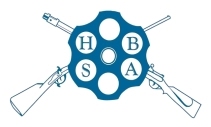A new range of targets is now available from the NRA that has been specifically designed for Historic rifle shooting. A brief explanation follows. The problem:In late 2015, the NRA announced that from 2016, they would only stock standard NRA Round Bull faces, the military style Fig 11 and Fig 12 faces and the usual Gallery targets. NRA black and white Tin Hat faces will no longer be available. The supply of Cadet Tin Hats will soon be exhausted and the Sand and Sky types are expensive. Also, they would no longer be able to store any privately owned or ‘one-off” style targets such as those that the HBSA used earlier, due to manpower reductions and the time consuming requirements of pasting on faces and adding extra scoring rings etc by hand. For the HBSA and other Historic shooters this decision posed a major problem ! Our Chairman, Derek Stimpson, approached the NRA Chief Executive, who has always been most supportive in recognising that Historic shooting is an important part of the NRA heritage and that it requires specific targets that reflect the golden era of competitive Service Rifle shooting. The NRA then very kindly agreed to obtain and pay for a new series of Round Bull and Tin Hat targets for 200, 300 and 500/600 yards to be called the ‘NRA/HBSA Historic Target’ and held in stock. A solution:Examination of NRA records revealed that during the .303 era, the dimensions of Bisley targets hardly changed between 1932 and 1971. However, when .303 was phased out and 7.62 came in, firstly a V Bull was introduced to reduce the number of ‘possibles’ in competitions. Then the scoring rings were reduced in size from 1972 and on two further occasions to reach the current 2016 dimensions. At the same time, the aiming mark (black) was enlarged considerably as bladed foresights and ‘laying-off” for wind disappeared to be replaced by ring foresights and click-stop adjustable rearsights. Producing a Historic version of the 900/1000 yard Long Range target was completely out of the question. However, if the NRA could produce a set of targets for 200, 300 and 500/600 yards to 1932/1971 dimensions, of which the Tin Hat was exactly one half of the Round Bull equivalent and a V Bull could be added to both to keep the best shots happy, then the problem would be solved ! The only restrictions that the NRA made were that both the 200 and 300 yard faces had to fit within the 36” square ‘bolt-on’ panels that they now use on Century and Short Siberia ranges to replace the shot-out central portion of the target backing without replacing the whole panel. Of neccessity, this has resulted in the Outer scoring ring having to be slightly compromised (shrunken) at 200 yards and rather more at 300 yards. The 500/600 faces are unaffected by this as they are not ‘bolt-ons’. These targets in both Round Bull and Tin Hat versions are now in NRA stock and have already been used at the 2016 Trafalgar Meeting. They will become the ‘Standard’ target for NRA Historic events and may be ordered by shooters who do not wish to use NRA Round Bull targets at medium range when booking range space. Hopefully, they will satisfy most Historic shooters as they can be used with a wide variety of rifles from muzzle loaders to early TR and with both iron and telescopic sights. Target Dimensions: (Inches) Round Bull and Tin HatNRA /HBSA Historic 2016 (Based on the NRA 1932 /1971 Target with added V Bull)
Current NRA 2016 Round Bull – for comparison
So we now have a set of Historic Targets for short and medium range that reflect the targets used by our predecessors from 1932 until the start of the 7.62 era in the early 1970s. Although the scoring rings are more generous, you will note that the Black (aiming mark) is smaller then the current NRA 2016 dimensions. This is exactly as it was in the heyday of .303 Service Rifle shooting and it is the same width as most Lee Enfield .303 foresight blades (6 m.o.a.) at all distances, making ‘laying-off’ easier. We must thank the NRA and in particular Peter Cottrell and the range staff, for their considerable help in supporting and paying for this venture. My personal thanks also go to John Fennell for his meticulous research into the history of target development and the assistance he gave me in this project. His research notes are attached below. Mike Townsend |
